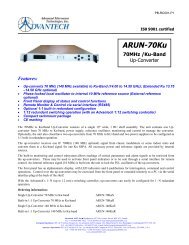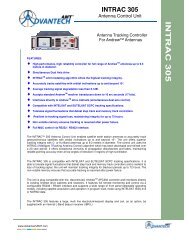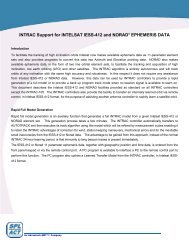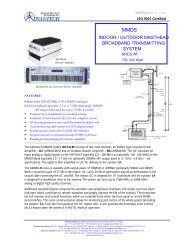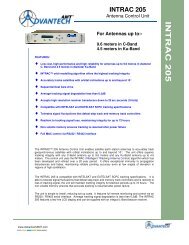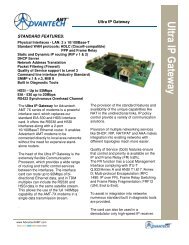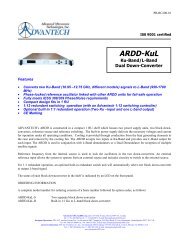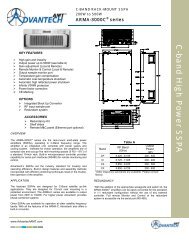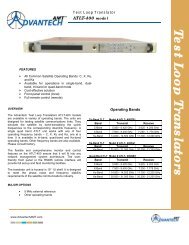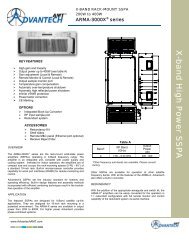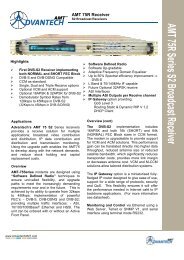History of our INTRAC antenna controllers - Advantech
History of our INTRAC antenna controllers - Advantech
History of our INTRAC antenna controllers - Advantech
You also want an ePaper? Increase the reach of your titles
YUMPU automatically turns print PDFs into web optimized ePapers that Google loves.
<strong>History</strong> <strong>of</strong> <strong>our</strong> <strong>INTRAC</strong> <strong>antenna</strong> <strong>controllers</strong>The development <strong>of</strong> Smooth Step Track/<strong>INTRAC</strong> <strong>antenna</strong> controlIn 1977 the British Post Office (BPO, the predecessor to BT) initiated the development <strong>of</strong> a new type <strong>of</strong> <strong>antenna</strong>control system because it anticipated a large increase in the number <strong>of</strong> <strong>antenna</strong> <strong>controllers</strong> it would need and wasdissatisfied with the cost, complexity and relative unreliability <strong>of</strong> the monopulse <strong>controllers</strong> available at that time. Itsobjective was to develop an <strong>antenna</strong> controller having the accuracy, and the ability to operate with satellites ininclined orbits, which is characteristic <strong>of</strong> monopulse control, but with pricing similar to that <strong>of</strong> inexpensive Steptrack<strong>controllers</strong>.A radically improved control algorithm was developed to meet this objective. This control algorithm was called SmoothStep Track and the first systems were installed and successfully operated at Goonhilly Earth Station in 1978/79. Thealgorithm was based on developing a mathematical model <strong>of</strong> the satellite orbit and steering the <strong>antenna</strong> in accordancewith this orbital model. The orbital model is developed from a large number <strong>of</strong> separate steptrack measurements <strong>of</strong> theposition <strong>of</strong> the satellite. Each <strong>of</strong> these measurements is derived by making a step cycle movement <strong>of</strong> the <strong>antenna</strong> andestimating the position <strong>of</strong> the satellite from the way the received signal varies during the step cycle. These individualmeasurements are then fitted to a generalized 14-parameter model <strong>of</strong> the satellite orbit, as viewed from the ground, inorder to match the observed movements <strong>of</strong> the satellite. The orbital model is fully developed after the first 24 h<strong>our</strong>s <strong>of</strong>tracking and is then kept updated by making step cycle measurements every ten minutes. This period is chosen so asto be sufficiently short to detect and correct for unexpected satellite station-keeping maneuvers.Because the <strong>antenna</strong> is steered in accordance with the orbital model and does not peak the signal on individualmeasurements, it has major advantages relative to basic step track. These advantages are described below.The <strong>INTRAC</strong> algorithm incorporates a number <strong>of</strong> intelligently adaptive features to cope with a wide range <strong>of</strong> differentconditions.The s<strong>of</strong>tware that had been developed for the original trial/demonstration units was licensed to Signal Processors LTD(now SPL-ACT wireless Europe limited) by BT in 1983 and SPL then designed and manufactured commercial <strong>antenna</strong>control units using this s<strong>of</strong>tware. Shortly after agreement <strong>of</strong> the license the specialist who had been responsible fordevelopment and coding <strong>of</strong> the original orbit modeling algorithm, Dr Martin Terrell, joined SPL and continued to designand develop improved <strong>antenna</strong> control systems based upon this algorithm. In order to differentiate the performance <strong>of</strong>the <strong>controllers</strong> from that <strong>of</strong> basic step track <strong>controllers</strong> the name <strong>of</strong> the algorithm was changed from Smooth Step Trackto <strong>INTRAC</strong>, for INtelligent TRacking Antenna Control.In addition to the basic advantages <strong>of</strong> accurate and reliable tracking even when satellites are in highly inclined orbits,<strong>INTRAC</strong> <strong>controllers</strong> also provide:• Tolerance <strong>of</strong> wind deflection <strong>of</strong> the <strong>antenna</strong>• Tolerance <strong>of</strong> satellite station keeping maneuvers• High tracking accuracy, particularly in conditions <strong>of</strong> fading and scintillationA large number <strong>of</strong> safety features which act to ensure that traffic is not lost by the <strong>antenna</strong> steering <strong>of</strong>f track, whichcould otherwise occur under exceptional operating conditions or some types <strong>of</strong> equipment failureAn <strong>Advantech</strong> AMT TM Company
<strong>History</strong> <strong>of</strong> <strong>our</strong> <strong>INTRAC</strong> <strong>antenna</strong> <strong>controllers</strong><strong>History</strong> <strong>of</strong> <strong>our</strong> <strong>INTRAC</strong> <strong>antenna</strong> <strong>controllers</strong>The improved <strong>INTRAC</strong> control algorithm provides a great improvement in reliability <strong>of</strong> tracking relative to basic steptrack<strong>controllers</strong>. The improvement is particularly great in difficult propagation conditions and also when tracking satellites ininclined orbits. Basic step track <strong>controllers</strong> move the <strong>antenna</strong> in order to directly maximize or peak-up the receivedsignal. <strong>INTRAC</strong> <strong>controllers</strong> make step cycles and uses these step cycles to measure the angular position <strong>of</strong> the satelliteand construct a mathematical model <strong>of</strong> the satellite orbit. <strong>INTRAC</strong> <strong>controllers</strong> then control the <strong>antenna</strong>, continuously ifnecessary, in accordance with this model.Ordinary step track <strong>controllers</strong> are not able to operate properly if the signal is scintillating or fading while the step trackcontroller is seeking to maximize the received signal. In these conditions the steptrack controller will be unable to peakthe signal successfully and will continue 'hunting' to find the peak as the signal scintillates. In order to be able to 'tweak'the system to minimize the inherent tracking deficiencies <strong>of</strong> simple step track, such step track <strong>controllers</strong> allow theoperator to modify the step track parameters, such as step size, step track gain, scan threshold, tracking interval, etc.In the case <strong>of</strong> the <strong>INTRAC</strong> operating under the same scintillating signal conditions the measurement <strong>of</strong> the satelliteposition will be made more uncertain by the scintillation. However, because the <strong>INTRAC</strong> controller uses advancedoptimal estimation techniques, it is still able to make an accurate model <strong>of</strong> the orbit by combining a large number <strong>of</strong>measurements, each <strong>of</strong> which can be subject to large uncertainty. Because <strong>of</strong> the design <strong>of</strong> the <strong>INTRAC</strong> algorithm noadjustment <strong>of</strong> operating parameters is needed because the controller itself characterizes the critical parameters <strong>of</strong> the<strong>antenna</strong> and automatically adjusts its operating parameters, such as step cycle frequency, to the correct values.A further point is that ordinary step track <strong>controllers</strong>, having maximized the signal, leave the <strong>antenna</strong> at that positionuntil they make another step track cycle. If the satellite is moving the signal strength will drop until the <strong>antenna</strong> ispeaked again. The result is that the <strong>antenna</strong> pointing always lags behind the position <strong>of</strong> the satellite and also that thereceived signal strength is less than the maximum except when it has just been peaked. Consequently, such <strong>controllers</strong>introduce signal loss, which increases with increasing orbital inclination <strong>of</strong> the satellite being tracked.An <strong>Advantech</strong> AMT TM Company
<strong>History</strong> <strong>of</strong> <strong>our</strong> <strong>INTRAC</strong> <strong>antenna</strong> <strong>controllers</strong>Some <strong>of</strong> the basic features <strong>of</strong> orbit modeling control are now also claimed by other suppliers, who first introducedtheir own orbit modeling <strong>controllers</strong> into the market about eight years after SPL had introduced its Smooth StepTrack <strong>controllers</strong>. These competing <strong>controllers</strong> are relatively unsophisticated and lack several features incorporatedin the <strong>INTRAC</strong> <strong>controllers</strong>. These other <strong>controllers</strong> generally lack:• the <strong>INTRAC</strong> noise processing ability• self adaptive features, such as automatic compensation for reasonable levels <strong>of</strong> wear and backlash inthe <strong>antenna</strong> drives• capacity to correct automatically for wind distortions <strong>of</strong> the <strong>antenna</strong> structure• the ability to continue tracking, without need to reset or re-acquire, through all normal types <strong>of</strong> satellitestation-keeping maneuvers.By contrast, these advanced features have been incorporated in the <strong>INTRAC</strong> algorithm over many years <strong>of</strong>continuous development. SPL-ACT wireless is unique as a manufacturer <strong>of</strong> <strong>antenna</strong> control systems in the depth <strong>of</strong>its expertise in optimal estimation techniques and in signal processing techniques to extract the maximuminformation from noise-corrupted signals (an expertise also applied in the company's range <strong>of</strong> satellite modems). Asa result, competing <strong>controllers</strong>, which do not incorporate noise processing algorithms <strong>of</strong> the same power, operateless well in conditions <strong>of</strong> high scintillation, are less able to cope with unexpected station keeping maneuvers and areless able to cope with wind distortions or deflections <strong>of</strong> the <strong>antenna</strong> reflector which are not detected by the positiontransducers. These differences result in tracking performance which is less robust against such phenomena.Another result <strong>of</strong> <strong>our</strong> 19 year program <strong>of</strong> on-going development is that the <strong>INTRAC</strong> hardware and s<strong>of</strong>tware areextremely reliable and well proven. We are not aware <strong>of</strong> any case where an <strong>INTRAC</strong> <strong>antenna</strong> control system haslost traffic after the control system has been commissioned except as a result <strong>of</strong> a hardware failure. In more than 16million operational h<strong>our</strong>s to date <strong>INTRAC</strong> <strong>controllers</strong> have achieved an average MTBF <strong>of</strong> 128,000 h<strong>our</strong>s, or onaverage more than 14 years between failures.The excellent performance <strong>of</strong> <strong>INTRAC</strong> control has been well established by its use on over 350 <strong>antenna</strong>s, many <strong>of</strong>which are tracking at very low angles <strong>of</strong> elevation in conditions <strong>of</strong> severe atmospheric scintillation and rain fading inthe tropics, and its use over many years for tracking military communications satellites with orbital inclinationsgreater than 7 o .Although most <strong>of</strong> the supplied control systems are installed by the end users or system integration companies, wehave personally completed over 70 <strong>antenna</strong> control retr<strong>of</strong>its at earth stations in the UK and Europe, North America,the Pacific, India, Thailand, Singapore, Hong Kong, the Caribbean and Middle East.Twelve <strong>of</strong> these retr<strong>of</strong>its have been on 30/32m diameter C Band <strong>antenna</strong>s and one on a 17m wheel and track<strong>antenna</strong> where <strong>INTRAC</strong> is the only means <strong>of</strong> control.An <strong>Advantech</strong> AMT TM Company
<strong>History</strong> <strong>of</strong> <strong>our</strong> <strong>INTRAC</strong> <strong>antenna</strong> <strong>controllers</strong>Based on these practical reliability figures, the estimated time to replace the sub-system and therefore the time lost peryear as a consequence <strong>of</strong> a failure are summarized below:Item% failure peryearTime toreplaceMinutes lost peryear<strong>INTRAC</strong> 505 ACU plus IBR-L Beacon 15.8% 30 minutes 4.78 minutesReceiverResolvers 0.7% 120 minutes 0.84 minutesC Band to L Band Block Down1.8% 20 minutes 0.4 minutesConverterMotor Control Unit 1.8% 90 minutes 1.6 minutesTotal7.7 minutesBased on the above estimated times to replace faulty sub-systems the estimated average period <strong>of</strong> traffic lost peryear as a result <strong>of</strong> tracking system failures is 7.7 minutes. This translates to a very high availability equal to99.998%.Please note that because the <strong>INTRAC</strong> systems can control the <strong>antenna</strong> in accordance with their internal orbitalmodel data, a considerable number <strong>of</strong> hardware failures, for example any failure in the Block Down Converter orthe integral beacon receiver in the ACU, or a failure in the ACU display circuits, will not affect the ability <strong>of</strong> thecontroller to continue to control the <strong>antenna</strong>. Therefore the availability for maintaining tracking and thereforeprotecting data traffic on the <strong>antenna</strong>, will actually be higher than would be assumed from the above conventionalsystem availability calculations.Intelligently Adaptive to Operating ConditionsAs noted in section 1.4.6 above, the <strong>INTRAC</strong> code incorporates many features to improve operational reliability andtolerance to non-ideal operating conditions. These special features include the ability to sense, and automatically correctfor, moderate levels <strong>of</strong> wear and backlash in the <strong>antenna</strong> drives and small nonlinearities in the resolver positiontransducers. This means that <strong>INTRAC</strong> <strong>controllers</strong> will continue to operate correctly even when there is progressive wear inthe <strong>antenna</strong> drive mechanism, provided that the wear is not excessive.The controller will also sense when there is a satellite station keeping maneuver, wind distortion <strong>of</strong> the <strong>antenna</strong> orexcessive scintillation or rain fading which is reducing the accuracy <strong>of</strong> its satellite position measurements, and willautomatically increase the frequency <strong>of</strong> its step cycle measurements to compensate.No requirement for parameter adjustmentBecause the <strong>INTRAC</strong> algorithm is intelligently adaptive to operating conditions there is no need for the operator to adjust ortry to optimize the operating parameters <strong>of</strong> the <strong>INTRAC</strong> control. This contrasts strongly with step-track based <strong>controllers</strong>which <strong>of</strong>ten require operator adjustment <strong>of</strong> parameters including size <strong>of</strong> step track movements, frequency <strong>of</strong> step trackcycles, step track gain, level <strong>of</strong> beacon change before new step track cycle is initiated, etc.An <strong>Advantech</strong> AMT TM Company
<strong>History</strong> <strong>of</strong> <strong>our</strong> <strong>INTRAC</strong> <strong>antenna</strong> <strong>controllers</strong>The only parameters that need to be entered when a controller is installed on a new <strong>antenna</strong> are the <strong>antenna</strong> beamwidth,the resolver position <strong>of</strong>fsets, if any, and the beacon signal frequency. All other parameter adjustment is automatic.Acceptance <strong>of</strong> IESS 412 or NORAD Track Data.Although <strong>INTRAC</strong> <strong>controllers</strong> can develop a fully accurate orbital model in 24 h<strong>our</strong>s from switch-on and normally operateentirely autonomously, they can accept IESS 412 or NORAD Program Track data and use this information to immediatelycompute the corresponding <strong>INTRAC</strong> model and start tracking according to this model. They will then progressively refinethis model via the normal step cycle measurements to improve and maintain its accuracy.Minimization <strong>of</strong> Drive WearBecause <strong>INTRAC</strong> <strong>controllers</strong> do not attempt to peak the signal strength during the period when they move the <strong>antenna</strong> tomeasure the satellite position, and only move the <strong>antenna</strong> when necessary to maintain the pointing loss below 1/20 <strong>of</strong> abeamwidth or less, <strong>INTRAC</strong> <strong>controllers</strong> do not "thrash" in response to noise or scintillation on the beacon signal. Thisabsence <strong>of</strong> thrashing protects the drives from wear and helps to extend their life, in some cases by a factor <strong>of</strong> twenty ormore times relative to basic step track <strong>controllers</strong>.Ease <strong>of</strong> Installation<strong>INTRAC</strong> <strong>antenna</strong> control systems are very easy to install on a wide range <strong>of</strong> different types <strong>of</strong> <strong>antenna</strong>s (C band, X bandand Ku band) with a wide range <strong>of</strong> beamwidths. To date they have also been installed on <strong>antenna</strong>s manufactured by atleast 25 different organizations.The only parameters in the <strong>INTRAC</strong> <strong>antenna</strong> controller which need to be set at the time <strong>of</strong> installation are the <strong>antenna</strong>beamwidth and the angular <strong>of</strong>fsets (if any) <strong>of</strong> the azimuth and elevation position transducers. (Clearly it is necessary forthese to be properly mounted and coupled correctly to the azimuth and elevation axes <strong>of</strong> the reflector.)Therefore there is no need for other operator adjustable parameters to match the controller to the type <strong>of</strong> <strong>antenna</strong> and thesignal conditions, as is the case with signal peaking, step-track-based <strong>controllers</strong>. The controller is intelligently adaptive tothe signal conditions and also to the mechanical characteristics <strong>of</strong> the <strong>antenna</strong> drives.Provided that the <strong>antenna</strong> drives are mechanically sound and do not suffer from backlash or overrun which exceeds about1/40 <strong>of</strong> a beamwidth, the <strong>INTRAC</strong> ACU will automatically measure and compensate for the <strong>antenna</strong> drive characteristicsand will accurately control the <strong>antenna</strong> with a precision determined by the resolution <strong>of</strong> the position transducers.The result is that <strong>INTRAC</strong> control system are quick and trouble free to install, do not require any special expertise to "tune"them to the particular <strong>antenna</strong> being used, and are genuinely "point and track" units.Minimum Requirement for Routine MaintenanceThere is no requirement for routine maintenance <strong>of</strong> any parts <strong>of</strong> an <strong>INTRAC</strong> <strong>antenna</strong> control system.SPL-ACT wireless Europe Ltdoperates an ISO9001 compliantQuality Management System, whichis approved bySPL-ACT wireless reserves the right toalter this specification without noticeAn <strong>Advantech</strong> AMT TM Company



